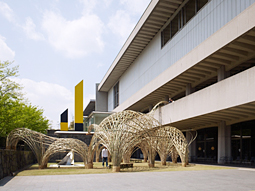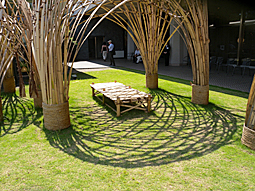 |
|
 |
Giant bamboo animals lighten the formal atmosphere of the museum's courtyard and provide a whimsical place to catch a bit of shade in an installation entitled Rendez-vous, by Yoshiharu Tsukamoto and Momoyo Kaijima of Atelier Bow-Wow.
© Atelier Bow-Wow; photos © Daici Ano (left) and Susan Rogers Chikuba (right)
|
When was the last time you enjoyed a lively exchange with one of those security personnel who hover in the corners of museum galleries? That's just one of the vibes that feels different at the provocative Where is Architecture? exhibition now on through August 8 at The National Museum of Modern Art, Tokyo (MOMAT).
The museum has allocated all of its ground-floor galleries to the show, its first full-scale exhibition to focus exclusively on Japanese architects. In seven installations, eight designers ranging in age from 38 to 69 -- Yoshiharu Tsukamoto and Momoyo Kaijima of Atelier Bow-Wow, Ryuji Nakamura, Hideyuki Nakayama, Ryoji Suzuki, Hiroshi Naito, Hiroshi Kikuchi, and Toyo Ito -- present a mixed showcase of theory, technique, and aesthetics in response to the exhibition title, each installation prompting still further questions.
Also contributing to the open-ended energy here is the museum's decision to allow photography anywhere within the galleries. (That's sans flash though, and some common-sense rules do apply.) This freedom encourages a more personal response to the installations, and triggers interactions between strangers, too. Visitors can keep the dialogue going by posting their images to a public group on Flickr created for that purpose. But above all, perhaps the best indication of the show's success is that anyone who has been to it seems to come away with a different favorite among the seven installations.
The playfulness starts outside, in the museum's courtyard. Referencing both MOMAT's location in the Takebashi ("bamboo bridge") district and the wooded grounds of the Imperial Palace just across the street, Atelier Bow-Wow used summery bamboo to construct a herd of gigantic animals that seem to have emerged from the woods to graze on the lawn -- and see what's on. Their arching underbellies provide welcome shade, drawing visitors in toward the more formal architecture of the building.
Once inside, Ryuji Nakamura's cornfield -- a 100-cubic-meter structure that you can see through but can't move through -- is as intricately delicate as it is massive in scale, and it's staggering to consider the labor involved in its creation. The work's geometric patterning summons comparisons between our relationship to the built environment and our romanticized view of the pastoral.
The installations by Hideyuki Nakayama and Ryoji Suzuki, entitled Door on the Prairie and Experience in Material No. 51: DUBHOUSE respectively, seemed to generate particular excitement among young students of art and design. More conceptual art than architecture, Nakayama's installation examines the relationship between space and the body with Alice-in-Wonderland-esque reductions in proportion and tricks of perception. Suzuki's work, too, plays with proportion and depth of field. Compare his three scale models of a residence now under construction against the larger installation. While the rooms correspond in placement, the length, width, and height of the installation's spaces have been wildly compressed or elongated out of scale. Is it still architecture if human occupation has been removed from the equation? You decide.
The most eloquent designs often derive from a momentary flash of inspiration. Hiroshi Naito's Akajima (Red Stripes) is the simplest of the seven exhibits and is based on the architect's chance encounter with the light emitted by a laser plummet, a tool used at construction sites for leveling and alignment. In a large, empty, and darkened gallery, 200 laser lights embedded in the ceiling project a rectangular field of thin red lines on the floor. Don't be shy, step right in. Only when someone -- or something -- enters this zone, and the lines of light superimpose to reveal those contours, does the field assume any three-dimensional form. White scarves are provided at the entranceway to throw, twirl, flourish, or otherwise play with as you wish. "Abstract expression of space was the dream of twentieth-century modernity," explains Naito. "My installation represents a mere fragment of that vision." Complimentary mime-like dance performances will be held twice daily in the space on July 9, 10, 11, 23 and 25; check the MOMAT site for details.
Just as in the real world, sometimes a powerful design statement travels a more tortuous path to realization. Luck of the draw assigned Hiroshi Kikuchi a difficult gallery in which to present his signature themes of light and space -- a tight, turning, windowless room with irregularly placed columns. Yet his exploration of solar movement, shadow, and the passage of time in one day in a room rises to the challenge brilliantly. A stationary scale model, a thick wad of cables, a suspended video camera, a light source set on a rotating dais, and a sofa make for a puzzling exhibit at first. But linger a while to see what meanings unfold via the combined effects of light modulation, chromatic aberration, sound, and the change of scene when you move around the corner. Of all the seven, this is perhaps the installation that evokes the most personal, and therefore the most varied, reactions from observers. Where you find the answer to the exhibition's titular question here will depend on where you stand or sit, how you're accustomed to looking, and in what direction you focus your gaze. Don't be rushed.
The last of the seven, Toyo Ito's inside in, eschews vertical columns and walls, using instead three types of polyhedra to build and define space. A few of his recent projects and new concepts for spatial systems are displayed on the slanting walls of this "museum within a museum."
Whatever your preferences and biases about what does or should define design, go. See. Feel. Take advantage of the rare opportunity to snap photos freely in the classic interior spaces by the late Yoshiro Taniguchi, and seek your own answers to the question, "Where is architecture?" The museum invites you to share your findings with the world here.
|